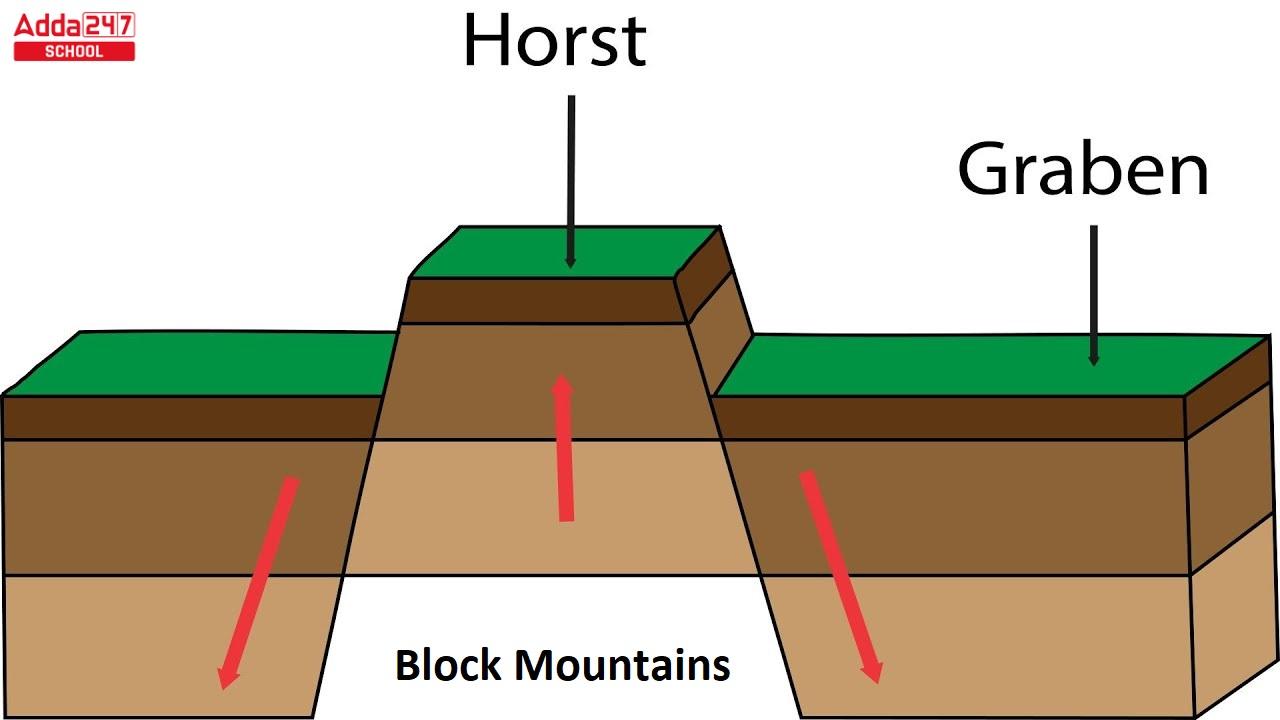Table of Contents
Block Mountains: Generally, students who study the Geography of the earth, also study Block Mountains. Block Mountain is not a New term for geography students. We have mentioned its definition and its generation process in this article.
But, Block Mountains are not just of it. There are many other layers of information awaiting to be unveiled. If you are also here to know more about Block Mountains, then please read this article fully.
What is a mountain?
A mountain is a large landform that rises high above the surrounding land in a limited area. It is typically formed as a result of tectonic activity or volcanic eruptions. Mountains are characterized by steep slopes, rugged terrain, and an elevation of at least 1,000 feet (305 meters) above the surrounding land.
They can be found all over the world, and many are popular tourist destinations for hiking, skiing, and other outdoor activities. Mountains also play a crucial role in regulating the Earth’s climate and water cycle, and they are home to a variety of plant and animal species.
Types of mountains
There are different types of mountains, and they can be classified based on how they were formed. Here are the main types of mountains:
| Types | Explanation |
| Fold Mountains | These mountains are formed by the folding of rock layers due to tectonic activity. Examples include the Himalayas, the Alps, and the Rocky Mountains. |
| Fault-Block Mountains | These mountains are formed when blocks of the Earth’s crust are uplifted and tilted along fault lines. Examples include the Sierra Nevada Mountains in California and the Harz Mountains in Germany. |
| Dome Mountains | These mountains are formed when magma rises and uplifts the Earth’s crust, creating a dome-shaped structure. Examples include the Black Hills in South Dakota and the Adirondack Mountains in New York. |
| Volcanic Mountains | These mountains are formed by the accumulation of volcanic material, such as lava and ash. Examples include Mount Fuji in Japan and Mount Kilimanjaro in Tanzania. |
| Plateau Mountains | These mountains are formed when a plateau is uplifted and eroded, creating steep slopes and sharp peaks. Examples include the Colorado Plateau in the United States and the Ethiopian Highlands in Africa. |
Geology of Block Mountains
The Block mountains which is also known as fault-block mountains, are get into the form when large blocks of the Earth’s crust are uplifted and tilted along fault lines. This creates steep slopes on one side of the block and gentler slopes on the other side. The geology of block mountains is characterized by a complex interplay of tectonic forces and erosion.
In the start of the making of block mountain, tensional forces in the Earth’s crust cause the crust to break along a breaking line or fault line. The resulting blocks of crust are then pushed up or down, depending on the direction of the forces involved. Over time, erosion wears away the softer rock on the gentler slopes, while the harder rock on the steep slopes is exposed and eroded more slowly.
As the block mountain rises, it may also be subject to further tectonic activity, such as earthquakes or volcanic eruptions. These events can cause other deformation and erosion, shaping the mountain and creating new features such as canyons, cliffs, and valleys.
Formation of Block Mountains
We have listed the steps that are generally getting into use while making of or formation of block mountains naturally
Step-1: Tectonic forces create a fault
Block mountains are formed when large blocks of the Earth’s crust are uplifted and tilted along a fault line. The fault is created by tensional forces that pull the crust apart.
Step-2: Blocks of crust are uplifted
As the tensional forces continue, the blocks of crust are pushed up or down, depending on the direction of the forces involved. In the case of block mountains, the blocks are pushed up, creating steep slopes on one side and gentler slopes on the other.
Step-3: Erosion wears down the softer rock
Over time, erosion wears away the softer rock on the gentler slopes. This exposes the harder rock on the steep slopes, which erodes more slowly.
Step-4: The mountain continues to rise
As block mountain continues to rise, it may also be subject to further tectonic activity, such as earthquakes or volcanic eruptions. These events can cause further deformation and erosion, shaping the mountain and creating new features such as canyons, cliffs, and valleys.
Step-5: The process continues
The process of block mountain formation continues as long as tectonic forces continue to act on the Earth’s crust. Over millions of years, block mountains can reach great heights and become important geological features of the landscape.
Examples of block mountains
Here, we’ve added around 10 examples of block mountains:
| Example | Example |
| Sierra Nevada Mountains, California, United States | Harz Mountains, Germany |
| Sangre de Cristo Mountains, New Mexico and Colorado, United States | Vosges Mountains, France and Germany |
| Organ Mountains, New Mexico, United States | Jura Mountains, Switzerland and France |
| Tetons, Wyoming, United States | Vogelsberg Mountains, Germany |
| Wasatch Mountains, Utah, United States | Black Forest, Germany |
Block Mountains- Types of faults
There are two main types of faults that can result in the formation of block mountains:
Normal faults
Normal faults occur when tensional forces pull the Earth’s crust apart, causing one side of the fault to drop down relative to the other side. This creates a steep slope on one side of the block and a gentler slope on the other side. Normal faults are the most common type of fault associated with block mountain formation.
Reverse faults
Reverse faults occur when compressional forces push the Earth’s crust together, causing one side of the fault to move up relative to the other side. This can also result in the formation of block mountains, with a steep slope on one side and a gentler slope on the other side. Reverse faults are less common than normal faults for block mountain formation, but they can still play a role in their formation.
Block Mountains Examples in India
India is known for its diverse and varied topography, and there are several examples of block mountains in the country. Block mountains are formed when large sections of the Earth’s crust are uplifted along faults or fractures. Here are some examples of block mountains in India:
- Aravalli Range: The Aravalli Range, stretching across the states of Rajasthan, Haryana, and Gujarat, is one of the oldest fold mountain systems in the world. It is formed by a series of block mountains and is known for its rich mineral resources.
- Vindhya Range: The Vindhya Range, located in central India, is a complex mountain system that includes block mountains. It separates the Indo-Gangetic plains from the Deccan Plateau and is known for its scenic beauty.
- Satpura Range: The Satpura Range, located in central India, is a series of block mountains that run parallel to the Vindhya Range. It is characterized by rugged terrain, deep valleys, and dense forests.
- Eastern Ghats: The Eastern Ghats, running along the eastern coast of India, comprise several block mountains. They extend from Odisha in the north to Tamil Nadu in the south and are known for their scenic landscapes and waterfalls.
- Western Ghats: The Western Ghats, also known as the Sahyadri Range, is a UNESCO World Heritage Site and consists of several block mountains. They run parallel to the western coast of India and are famous for their biodiversity and lush green forests.
- Dhauladhar Range: The Dhauladhar Range, located in the Indian state of Himachal Pradesh, is a part of the larger Himalayan mountain system. It consists of block mountains and is known for its snow-capped peaks, deep valleys, and scenic beauty.
These are just a few examples of block mountains in India. The country has a diverse range of mountain systems, each with its unique geological features and characteristics.



 JEE Mains Session 2 Result 2025 Live: Sc...
JEE Mains Session 2 Result 2025 Live: Sc...
 CUET Political Science Chapter Wise Weig...
CUET Political Science Chapter Wise Weig...
 [Live Update] NTA CUET PG Answer Key 202...
[Live Update] NTA CUET PG Answer Key 202...










